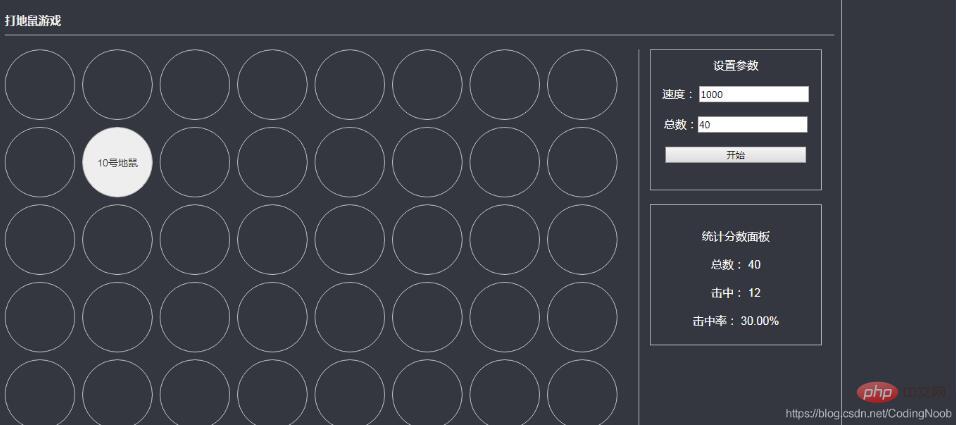Werfen wir einen Blick darauf, wie Vue das Whack-a-Mole-Spiel umsetzt

[Verwandte Lernempfehlungen: js-Video-Tutorial]
Das Beispiel in diesem Artikel teilt Ihnen den spezifischen Code für die Implementierung des Whack-a-Mole-Spiels in Vue als Referenz mit. Der spezifische Inhalt lautet wie folgt:
Das Rendering ist wie folgt: 
<template>
<p class="game">
<h2>打地鼠游戏</h2>
<p class="wraper">
<p class="item" v-for="n in TOTAL" :key="n">
<p :style="{'visibility': random === n ? 'visible' : 'hidden'}" @click="clickItem">{{n}}号地鼠</p>
</p>
</p>
<p class="scoped">
<p class="set">
<p>设置参数</p>
<p>
速度: <input type="number" v-model="setSpeed">
</p>
<p>
总数:<input type="number" v-model="setNum">
</p>
<p>
<button @click="playGame">开始</button>
</p>
</p>
<p class="count set">
<h3>统计分数面板</h3>
<h3>总数: {{TOTAL}}</h3>
<h3>击中: {{clickNum}}</h3>
<h3>击中率: {{level}}%</h3>
</p>
</p>
</p>
</template>
<script>
export default {
name: 'App',
data () {
return {
clickFlag: true, // 单个地鼠只能点击一次
setNum: 40, // 绑定设置地洞数量
setSpeed: 1000, // 绑定设置地鼠出现速度
speed: 2000, // 地鼠出现速度
random: '', // 随机出现的地鼠位置
TOTAL: 40, // 地鼠总数
count: 0, // 统计总共出现了多少次地鼠同于判断不能大于总数
clickNum: 0, // 点中地鼠统计
timmerId: null
};
},
computed: {
// 统计打中的地鼠数量
level: function () {
let num = ((this.clickNum / this.TOTAL) * 100).toFixed(2) || 0;
return num;
}
},
created () {
},
mounted () {
},
methods: {
// 开始游戏
playGame () {
this.random = '';
this.speed = parseInt(this.setSpeed);
this.TOTAL = parseInt(this.setNum);
clearInterval(this.timmerId);
this.timmerId = setInterval(() => {
this.random = Math.floor(Math.random() * this.TOTAL + 1);
this.clickFlag = true; // 开放点击
this.count++;
if (this.count >= this.TOTAL) {
clearInterval(this.timmerId);
}
}, this.speed);
},
// 点击地鼠
clickItem () {
if (this.clickFlag) {
(this.count < this.TOTAL) && this.clickNum++;
this.clickFlag = false;
}
}
}
};
</script>
<style lang="less" scoped>
.game {
border: 1px solid #ccc;
width: 1200px;
padding: 10px;
user-select: none;
&::after {
content: "";
display: block;
clear: both;
}
h2 {
font-size: 16px;
color: #eee;
padding: 10px 0;
margin-bottom: 20px;
border-bottom: 1px solid #ccc;
}
.wraper {
width: 900px;
float: left;
}
.scoped {
width: 260px;
height: 540px;
float: left;
padding-left: 15px;
border-left: 1px solid #ccc;
h3 {
font-size: 16px;
color: #fff;
}
.set {
height: 200px;
width: 100%;
border: 1px solid #ccc;
p {
padding: 10px;
text-align: center;
color: #fff;
font-size: 16px;
button {
width: 90%;
}
}
}
.count {
.set;
margin-top: 20px;
padding-top: 25px;
text-align: center;
line-height: 40px;
h3 {
font-weight:normal;
}
}
}
.item {
display: inline-block;
height: 100px;
width: 100px;
border-radius: 50px;
margin: 0 10px 10px 0;
text-align: center;
line-height: 100px;
font-size: 20px;
border: 1px solid #ccc;
p {
height: 100%;
background: #eee;
border-radius: 50px;
}
}
}
</style>Empfohlene verwandte Bilder und Texte:js Tutorial (Bilder und Texte)
Das obige ist der detaillierte Inhalt vonWerfen wir einen Blick darauf, wie Vue das Whack-a-Mole-Spiel umsetzt. Für weitere Informationen folgen Sie bitte anderen verwandten Artikeln auf der PHP chinesischen Website!

Heiße KI -Werkzeuge

Undresser.AI Undress
KI-gestützte App zum Erstellen realistischer Aktfotos

AI Clothes Remover
Online-KI-Tool zum Entfernen von Kleidung aus Fotos.

Undress AI Tool
Ausziehbilder kostenlos

Clothoff.io
KI-Kleiderentferner

Video Face Swap
Tauschen Sie Gesichter in jedem Video mühelos mit unserem völlig kostenlosen KI-Gesichtstausch-Tool aus!

Heißer Artikel

Heiße Werkzeuge

Notepad++7.3.1
Einfach zu bedienender und kostenloser Code-Editor

SublimeText3 chinesische Version
Chinesische Version, sehr einfach zu bedienen

Senden Sie Studio 13.0.1
Leistungsstarke integrierte PHP-Entwicklungsumgebung

Dreamweaver CS6
Visuelle Webentwicklungstools

SublimeText3 Mac-Version
Codebearbeitungssoftware auf Gottesniveau (SublimeText3)

Heiße Themen
 1393
1393
 52
52
 So verwenden Sie Bootstrap in Vue
Apr 07, 2025 pm 11:33 PM
So verwenden Sie Bootstrap in Vue
Apr 07, 2025 pm 11:33 PM
Die Verwendung von Bootstrap in Vue.js ist in fünf Schritte unterteilt: Startstrap installieren. Bootstrap in main.js. Verwenden Sie die Bootstrap -Komponente direkt in der Vorlage. Optional: benutzerdefinierter Stil. Optional: Verwenden Sie Plug-Ins.
 So fügen Sie Funktionen zu Schaltflächen für Vue hinzu
Apr 08, 2025 am 08:51 AM
So fügen Sie Funktionen zu Schaltflächen für Vue hinzu
Apr 08, 2025 am 08:51 AM
Sie können der VUE -Taste eine Funktion hinzufügen, indem Sie die Taste in der HTML -Vorlage an eine Methode binden. Definieren Sie die Methode und schreiben Sie die Funktionslogik in der VUE -Instanz.
 So verweisen Sie auf die JS -Datei mit Vue.js
Apr 07, 2025 pm 11:27 PM
So verweisen Sie auf die JS -Datei mit Vue.js
Apr 07, 2025 pm 11:27 PM
Es gibt drei Möglichkeiten, sich auf JS -Dateien in Vue.js zu beziehen: Geben Sie den Pfad direkt mit dem & lt; Skript & gt an. Etikett;; Dynamischer Import mit dem montierten () Lebenszyklushaken; und importieren über die Vuex State Management Library.
 So verwenden Sie Watch in Vue
Apr 07, 2025 pm 11:36 PM
So verwenden Sie Watch in Vue
Apr 07, 2025 pm 11:36 PM
Mit der Watch -Option in Vue.js können Entwickler auf Änderungen in bestimmten Daten anhören. Wenn sich die Daten ändert, löst sich eine Rückruffunktion aus, um Aktualisierungsansichten oder andere Aufgaben auszuführen. Zu den Konfigurationsoptionen gehören unmittelbar, die festlegen, ob ein Rückruf sofort ausgeführt werden soll, und Deep, das feststellt, ob Änderungen an Objekten oder Arrays rekursiv anhören sollen.
 Was bedeutet VUE Multi-Page-Entwicklung?
Apr 07, 2025 pm 11:57 PM
Was bedeutet VUE Multi-Page-Entwicklung?
Apr 07, 2025 pm 11:57 PM
VUE Multi-Page-Entwicklung ist eine Möglichkeit, Anwendungen mithilfe des Vue.js-Frameworks zu erstellen, in dem die Anwendung in separate Seiten unterteilt ist: Code-Wartung: Die Aufteilung der Anwendung in mehrere Seiten kann das Verwalten und Wartungsbereich erleichtern. Modularität: Jede Seite kann als separates Modul für eine einfache Wiederverwendung und den Austausch verwendet werden. Einfaches Routing: Die Navigation zwischen Seiten kann durch einfache Routing -Konfiguration verwaltet werden. SEO -Optimierung: Jede Seite hat eine eigene URL, die SEO hilft.
 So kehren Sie von Vue zur vorherigen Seite zurück
Apr 07, 2025 pm 11:30 PM
So kehren Sie von Vue zur vorherigen Seite zurück
Apr 07, 2025 pm 11:30 PM
VUE.JS hat vier Methoden, um zur vorherigen Seite zurückzukehren: $ router.go (-1) $ router.back () verwendet & lt; Router-Link to = & quot;/& quot; Komponentenfenster.history.back () und die Methodenauswahl hängt von der Szene ab.
 So verwenden Sie Vue Traversal
Apr 07, 2025 pm 11:48 PM
So verwenden Sie Vue Traversal
Apr 07, 2025 pm 11:48 PM
Es gibt drei gängige Methoden für Vue.js, um Arrays und Objekte zu durchqueren: Die V-für-Anweisung wird verwendet, um jedes Element zu durchqueren und Vorlagen zu rendern; Die V-Bind-Anweisung kann mit V-für dynamisch Attributwerte für jedes Element verwendet werden. und die .MAP -Methode kann Array -Elemente in Neuarrays umwandeln.
 Wie man einen Tag zum Vue springt
Apr 08, 2025 am 09:24 AM
Wie man einen Tag zum Vue springt
Apr 08, 2025 am 09:24 AM
Zu den Methoden zum Implementieren des Sprung eines Tags in VUE gehören: Verwenden des A -Tags in der HTML -Vorlage, um das HREF -Attribut anzugeben. Verwenden Sie die Router-Link-Komponente des Vue-Routings. Verwenden Sie dies. $ Router.push () Methode in JavaScript. Parameter können durch den Abfrageparameter weitergeleitet werden, und Routen sind in den Routeroptionen für dynamische Sprünge konfiguriert.




